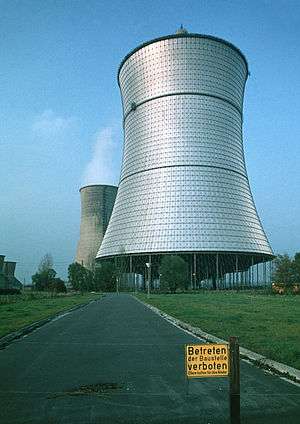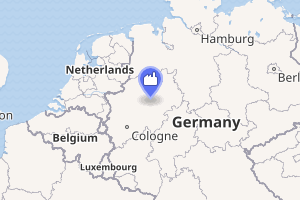THTR-300
The THTR-300 was a thorium high-temperature nuclear reactor rated at 300 MW electric (THTR-300) in Hamm-Uentrop, Germany. It started operating in 1983, synchronized with the grid in 1985, operated at full power in February 1987 and was shut down September 1, 1989.[1] The THTR-300 served as a prototype high-temperature reactor (HTR) to use the TRISO pebble fuel produced by the AVR, an experimental pebble bed operated by VEW. The THTR-300 cost €2.05 billion and was predicted to cost an additional €425 million through December 2009 in decommissioning and other associated costs. The German state of North Rhine Westphalia, Federal Republic of Germany, and Hochtemperatur-Kernkraftwerk GmbH (HKG) financed the THTR-300’s construction.[2]
| THTR-300 | |
|---|---|
 Cooling tower of the THTR-300 (demolished in 1991) | |

| |
| Country | Germany |
| Coordinates | 51°40′45″N 7°58′18″E |
| Construction began | 1971 |
| Commission date | November 16, 1985 |
| Decommission date | April 20, 1988 |
| Owner(s) | HKG |
| Operator(s) | HKG |
| Nuclear power station | |
| Reactor type | PBR |
| Power generation | |
| Units decommissioned | 1 × 308 MW |
| Nameplate capacity | 308 MW |
| Capacity factor | 40.1% |
| Annual net output | 1,083 GWh |
| External links | |
| Website | Official Site |
| Commons | Related media on Commons |
History
The European Council established on 4 June 1974 the Joint Undertaking "Hochtemperatur- Kernkraftwerk GmbH" (HKG).[3]
The electrical generation part of the THTR-300 was finished late due to ever-newer requirements and licensing procedures. It was constructed in Hamm-Uentrop from 1970 to 1983 by Hochtemperatur-Kernkraftwerk GmbH (HKG).[2] Heinz Riesenhuber, Federal Secretary of Research at that time, inaugurated it, and it first went critical on September 13, 1983. It started generating electricity on April 9, 1985, but did not receive permission from the atomic legal authorizing agency to feed electricity to the grid until November 16, 1985. It operated at full power in February 1987 and was shut down September 1, 1989, after operating for less than 16,000 hours.[1][4]
Because the operator did not expect the decision to decommission the facility, the plant was put into "safe enclosure" status, given that this was the only technical solution for fast decommissioning, especially in consideration of the lack of a final storage facility.[4]
Design
The THTR-300 was a helium-cooled high-temperature reactor with a pebble bed core consisting of approximately 670,000 spherical fuel compacts each 6 centimetres (2.4 in) in diameter with particles of uranium-235 and thorium-232 fuel embedded in a graphite matrix. The pressure vessel that contained the pebbles was prestressed concrete. The THTR-300's power conversion system was similar to the Fort St. Vrain reactor in the USA, in that the reactor coolant transferred the reactor core's heat to water.
The thermal output of the core was 750 megawatts; heat was transferred to the helium coolant, which then transported its heat to water, which then was used to generate electricity via a Rankine cycle. Because this system used a Rankine cycle, water could occasionally ingress into the helium circuit. The electric conversion system produced 308 megawatts of electricity. The waste heat from the THTR-300 was exhausted using a dry cooling tower.
Incidents
On May 4, 1986, just 6 months after it had been connected to the power grid, a fuel pebble became lodged in a fuel feed pipe to the reactor core. Consequently, some radioactive dust was released to the environment. This happened just a couple of days after the Chernobyl disaster. The operators played down the incident, which caused a loss of confidence in the regulatory authorities. The Westphalia ministry of commerce created a fact finding committee. After a couple of weeks the power plant was switched on again, but the former supporters withdrew their backing. The reactor kept experiencing technical difficulties, with fuel elements breaking more often than anticipated. The fuel factory in Hanau was decommissioned for security reasons. The fuel supply had already been difficult before this decision, and now it was truly at risk. It was decided to shut down THTR-300. 80 incidents were logged in its short lifetime.[5] From 1985 to 1989, the THTR-300 registered 16410 operation hours and generated 2891000 MWh, according to a full-load working time of 423 days.
Decommissioning
On September 1, 1989, the THTR-300 was deactivated due to its rising cost; in August 1989, the THTR company almost bankrupted after a long period of shut down due to broken components in the hot gas duct. It had to be bailed out by the government with 92 million Mark.[6]
THTR-300 was only in full service for 423 days. On October 10, 1991, the 180-metre (590 ft) high dry cooling tower, which at one time was the highest cooling tower in the world, was explosively dismantled and from October 22, 1993 to April 1995 the remaining fuel was unloaded and transported to the intermediate storage in Ahaus. The remaining facility was "safely enclosed". Dismantling is not expected to start before 2027.
As with other inactive reactor facilities, costs are still being incurred. From 2013 to 2017, 23 Million Euro were budgeted for lighting, safeguarding and the storage of the pellets in the interim storage facility in Ahaus. As was determined in 1989, dismantling would begin after approximately 30 years in safe enclosure.[4]
Further development
By 1992, a group of firms planned to proceed with construction of a HTR-500, the successor of the THTR-300, but up-rated to a thermal output of 1250 megawatts and an electrical output of 500 megawatts.
See also
- Gas cooled fast reactor
- Pebble bed reactor
- Gas Turbine Modular Helium Reactor
- Anti-nuclear movement in Germany
References
- "The present state of the HTR concept based on experience gained from AVR and THTR". Archived from the original on June 4, 2011.
- "Decommissioning of the thorium high temperature reactor (THTR 300)" (PDF).
- "74/295/Euratom: Council Decision of 4 June 1974 on the establishment of the Joint Undertaking Hochtemperatur- Kernkraftwerk GmbH (HKG)". eur-lex.europa.eu. Retrieved 2019-11-03.
- Dietrich, G.; Roehl, N. (1996-12-31). "Decommissioning of the thorium high-temperature reactor, THTR 300". Transactions of the American Nuclear Society. 75. OSTI 426592.
- Westfälischer Anzeiger 13. September 2013 THTR: Das Milliardengrab von Uentrop wird 30 http://www.wa.de/lokales/hamm/uentrop/thtr-milliardengrab-hamm-uentrop-wird-jahre-3099260.html.
- Deutscher Bundestag Drucksache 477 (PDF) (PDF) (in German), 1989
External links
General
IAEA technical documents
- The THTR steam generator: design, manufacture and installation
- Gas-cooled reactor safety and licensing aspects
- THTR steam generator licensing experience as seen by the manufacturer
- Accident analysis and accident control for the THTR - 300 power plant
- Aspects of water and air ingress accidents in HTRs
- Safety concept of high-temperature reactors based on the experience with AVR and THTR
- The behaviour of spherical HTR fuel elements under accident conditions
